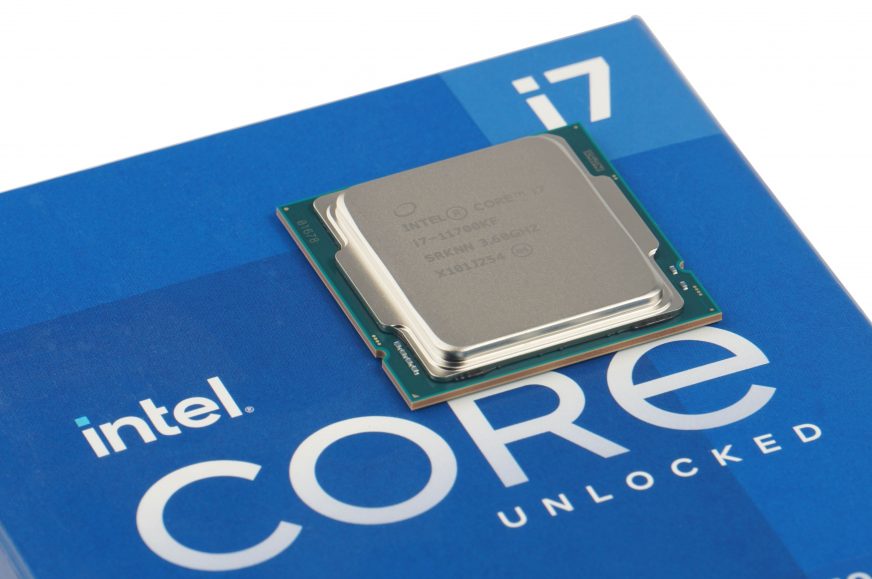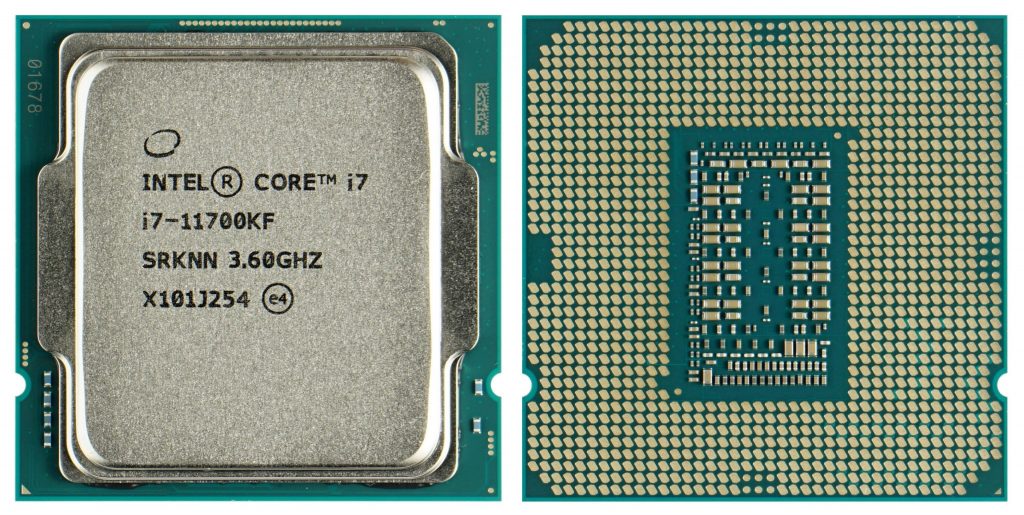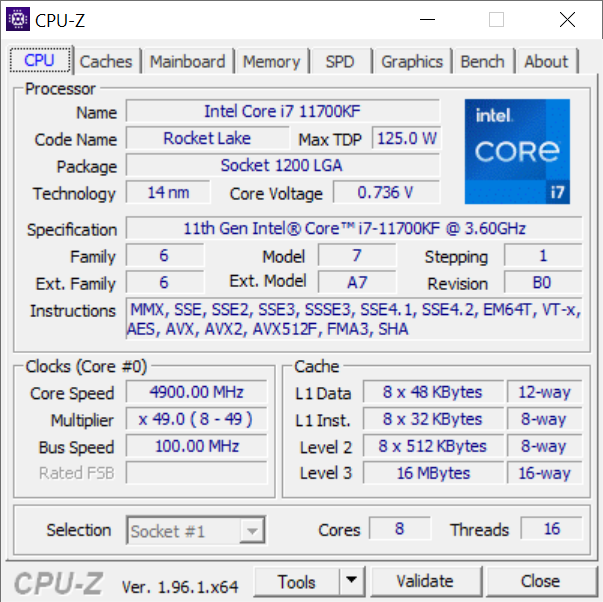Intel Core i7-11700KF in detail
8 cores, 16 threads. From this point of view, it is the same configuration as the Core i9-11900K(F). However, the Core i9 is a significantly more expensive processor and, especially in games, it has a much higher power consumption. At the same time, the difference in performance is minimal. It follows that with higher efficiency, the Core i7-11700K(F) has a more attractive price-performance ratio.
Top-end models of any hardware always have an unfavorable price-performance ratio, but Intel went even harder in the case of the Core i7-11900K, or the i7-11900KF. The MSRP increase over the Core i7-11700K(F) is $ 139–140, depending on whether we are comparing models with or without a functional integrated graphics core. The model with inactive iGPU is to have a dollar lower MSRP.
The price difference is about 18% lower ($ 114) between the Comet Lake Core i9-10900K(F) and the Core i7-10700K(F). Some might not even notice, but when you consider the even higher performance of the Ci9-10900K(F) compared to the two cores lighter Ci7-10700K(F), the surcharge for the faster but still octa-core Rocket Lake is getting real.
It’s true that the difference of single-core boost is 100 MHz higher for Rocket Lake processors, but that probably won’t be a good argument for the price increase. The Core i7-11700K(F) should reach only 5 GHz in single-core boost and the Core i9-11900K(F) up to 5.3 GHz. The Ci7-11700K(F) is not very different from the Ci9-11900K(F)—the cores are physically the same, with an area of 276.4 mm².
The PL1 limits (125 W) and PL2 (251 W) are also the same, but there is one interesting thing. The Core i7 has a reported 100 MHz higher base clock than the Core i9. This is likely because the Ci9-11900K(F) supports Gear 1 (1:1 memory divider) DDR4-3200 and the Ci7-11700K(F) officially supports Gear 1 DDR4-2933. The Ci7-11700K(F) is only intended to support the DDR4-3200 with Gear 2 (1:2 memory divider), but of course, only in the theoretical level of the least favorable interplay of circumstances (with relatively unsuitable memory modules and possibly in combination with a worse motherboard).
The specifications most likely count with this and it is expected that the Core i9 will have a higher memory controller power consumption. This means that the Core i9 will have more watts per core clock while respecting the Tau time limit with PL1 (TDP), bringing it to 3.6 GHz (and Ci9 will remain at 3.5 GHz). Under the same conditions, with the same Gear with the same fast memory, however, the Core i9 will not lag behind in performance.
We have the Core i7 Rocket Lake test model in the variant with an unlocked multiplier and with the iGPU inactive (i.e. 11700KF) against the Ci9-11900K, which has a graphic core that is functional. Otherwise, it does not differ from the model without iGPU (11900KF) in anything except a higher price. The price difference, which we wrote about in the introduction, applies to the comparison of processors with the same equipment (i.e. always with a graphics core or always without it). The Ci9-11900K with iGPU is, of course, an even more expensive processor compared to the tested Ci9-11700KF, and the difference in MSRP is $ 165. These recommended prices, after conversion into euros at the same exchange rate, also correspond to the current trend of market prices.
Let’s remind that the Core i7-11700KF and Rocket Lake processors generally support PCIe 4.0, are built on the new Cypress Cove architecture (but manufacturing process is still 14 nm) and have higher IPC than the previous Comet Lake-S generation, so you don’t have to worry about slightly reduced all-core boost clock.
| Manufacturer | Intel | Intel | |
| Line | Core i7 | Core i9 | |
| SKU | 11700KF | 11900K | |
| Codename | Rocket Lake | Rocket Lake | |
| CPU microarchitecture | Cypress Cove | Cypress Cove | |
| Manufacturing node | 14 nm | 14 nm | |
| Socket | LGA 1200 | LGA 1200 | |
| Launch date | 03/30/2021 | 03/30/2021 | |
| Launch price | 374 USD | 539 USD | |
| Core count | 8 | 8 | |
| Thread count | 16 | 16 | |
| Base frequency | 3.6 GHz | 3.5 GHz | |
| Max. Boost (1 core) | 5.0 GHz | 5.3 GHz | |
| Max. boost (all-core) | 4.6 GHz | 4.8 GHz | |
| Typ boostu | TBM 3.0, TVB, ABT | TBM 3.0, TVB, ABT | |
| L1i cache | 32 kB/core | 32 kB/core | |
| L1d cache | 48 kB/core | 48 kB/core | |
| L2 cache | 512 kB/core | 512 kB/core | |
| L3 cache | 1× 16 MB | 1× 16 MB | |
| TDP | 125 W | 125 W | |
| Max. power draw during boost | 251 W (PL2) | 251 W (PL2) | |
| Overclocking support | Yes | Yes | |
| Memory (RAM) support | DDR4-3200 | DDR4-3200 | |
| Memory channel count | 2× 64 bit | 2× 64 bit | |
| RAM bandwidth | 51.2 GB/s | 51.2 GB/s | |
| ECC RAM support | No | No | |
| PCI Express support | 4.0 | 4.0 | |
| PCI Express lanes | ×16 + ×4 | ×16 + ×4 | |
| Chipset downlink | DMI 3.0 ×8 | DMI 3.0 ×8 | |
| Chipset downlink bandwidth | 8.0 GB/s duplex | 8.0 GB/s duplex | |
| BCLK | 100 MHz | 100 MHz | |
| Die size | 276.4 mm² | 276.4 mm² | |
| Transistor count | ? bn. | ? bn. | |
| TIM used under IHS | Solder | Solder | |
| Boxed cooler in package | No | No | |
| Instruction set extensions | SSE4.2, AVX2, FMA, AVX-512, SHA, VNNI, GNA 2.0 | SSE4.2, AVX2, FMA, AVX-512, SHA, VNNI, GNA 2.0 | |
| Virtualization | VT-x, VT-d, EPT | VT-x, VT-d, EPT | |
| Integrated GPU | N/A | UHD 750 | |
| GPU architecture | – | Xe LP (Gen. 12) | |
| GPU: shader count | – | 256 | |
| GPU: TMU count | – | 16 | |
| GPU: ROP count | – | 8 | |
| GPU frequency | – | 350–1300 MHz | |
| Display outputs | – | DP 1.4a, HDMI 2.0b | |
| Max. resolution | – | 5120 × 3200 px (60 Hz) | |
| HW video decode | HW video decode | – | HEVC, VP9 |
| HW video encode | HW video encode | – | AV1, HEVC, VP9 |
- Contents
- Intel Core i7-11700KF in detail
- Methodology: performance tests
- Methodology: how we measure power draw
- Methodology: temperature and clock speed tests
- Test setup
- 3DMark
- Assassin’s Creed: Valhalla
- Borderlands 3
- Counter-Strike: GO
- Cyberpunk 2077
- DOOM Eternal
- F1 2020
- Metro Exodus
- Microsoft Flight Simulator
- Shadow of the Tomb Raider
- Total War Saga: Troy
- Overall gaming performance
- Gaming performance per euro
- PCMark and Geekbench
- Web performance
- 3D rendering: Cinebench, Blender, ...
- Video 1/2: Adobe Premiere Pro
- Video 2/2: DaVinci Resolve Studio
- Graphic effects: Adobe After Effects
- Video encoding
- Audio encoding
- Broadcasting (OBS and Xsplit)
- Photos 1/2: Adobe Photoshop and Lightroom
- Photos 2/2: Affinity Photo, Topaz Labs AI apps, ZPS X, ...
- (De)compression
- (De)cryption
- Numerical computing
- Simulations
- Memory and cache tests
- Processor power draw trend
- Average processor power draw
- Performance per watt
- Achieved CPU clock speed
- CPU temperature
- Conclusion










